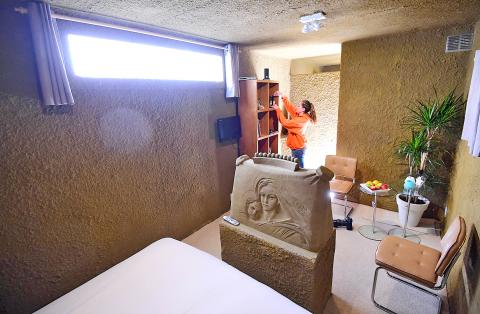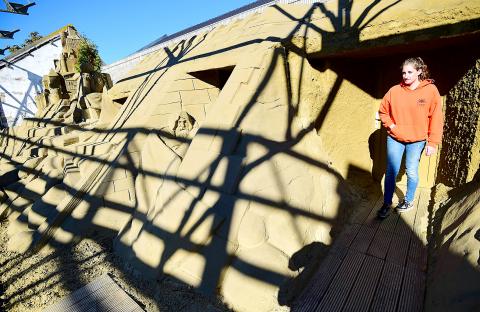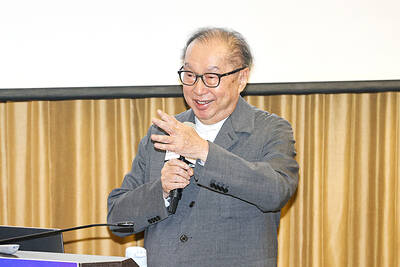Dutch sand sculptors have taken a childhood fantasy to a new level by creating the world’s first real-life “sandcastle hotel,” complete with a drawbridge and turrets.
Curious tourists and the young at heart flocked this summer to the small southern Dutch city of Oss to spend a night in a specially built room deep inside the massive sculpture made entirely of sand.
Constructed from tonnes of sand trucked in especially for the purpose and reinforced with wood, the room gives those spending the night the unique experience of sleeping in a real-life sandcastle, and comes complete with sand-carved sculptures.

Photo: AFP
“It’s crazy,” Dutch mechanic Erwin said after sleeping in the sand hotel to celebrate his “twelve-and-a-half year anniversary” with his partner.
“I wanted to do something special and it’s a bit of a childhood dream of mine to sleep in a sandcastle,” said Erwin, who declined to give his surname.
“The idea came from the ice hotels in Finland and Sweden,” says hotel manager Maud van Leeuwen, referring to the popular Scandinavian resorts that spring up in winter, featuring ice beds and room temperatures of about minus-8oC.

Photo: AFP
“We have many artists who work with both sand and ice and suddenly we thought — why not build a sand hotel?” Van Leeuwen said.
Conditions are less harsh at the sand hotel, with guests being welcomed by a comfortably turned-down bed and fully equipped bathroom for an overnight stay costing 150 euros (US$167). However, like the Scandinavian ice hotels, the sand hotel is built as an ephemeral artwork and will be broken down at the end of summer.
Two sand hotels were built in the Netherlands at venues where annual sand sculpture festivals are being held: one in Oss and the other in the northern Frisian city of Sneek.
In Oss, hotel guests can marvel at a collection of life-sized sand-sculpted dinosaurs, medieval explorers and robots, while a “trip through Asia” is the theme in Sneek.
Guests need not worry about getting sand in their beds: the hotel offers a luxurious overnight stay in a “regular” bed and the floor is lined with a plush grey carpet.
“People say: ‘It’s a sand hotel, it’s going to be a like a muddy puddle,’ but in fact it’s very luxurious,” Van Leeuwen laughed as she prepared the room, setting out two crystal glasses and a bottle of Italian bubbly.
The decor and structure is made from sand treated with a special lime to help it bind and harden, thereby preventing the room from crumbling in on its residents.
“The room was first built with wooden panels and then covered with sand,” for safety reasons, Van Leeuwen said.
A sand-carved bust of Cleopatra stands in one corner, while elsewhere in the room, the city of Oss is represented by its coat-of-arms — also in sand.
“Touch the walls — you can feel it’s very hard,” Van Leeuwen said.
Sadly, a stay at the sand hotel will soon come to an end with the summer, Van Leeuwen said, saying the venue premiered to a bumper season.
“I think for some people, it’s a childhood fantasy to sleep in a sandcastle, while for others it’s a bit like going on an adventure, or for a special occasion,” she said.
The sand hotels are expected to be back at same two venues next year — and will perhaps also make an appearance in Germany and Britain.

BYPASSING CHINA TARIFFS: In the first five months of this year, Foxconn sent US$4.4bn of iPhones to the US from India, compared with US$3.7bn in the whole of last year Nearly all the iPhones exported by Foxconn Technology Group (富士康科技集團) from India went to the US between March and last month, customs data showed, far above last year’s average of 50 percent and a clear sign of Apple Inc’s efforts to bypass high US tariffs imposed on China. The numbers, being reported by Reuters for the first time, show that Apple has realigned its India exports to almost exclusively serve the US market, when previously the devices were more widely distributed to nations including the Netherlands and the Czech Republic. During March to last month, Foxconn, known as Hon Hai Precision Industry

Taiwan Semiconductor Manufacturing Co (TSMC, 台積電) and the University of Tokyo (UTokyo) yesterday announced the launch of the TSMC-UTokyo Lab to promote advanced semiconductor research, education and talent development. The lab is TSMC’s first laboratory collaboration with a university outside Taiwan, the company said in a statement. The lab would leverage “the extensive knowledge, experience, and creativity” of both institutions, the company said. It is located in the Asano Section of UTokyo’s Hongo, Tokyo, campus and would be managed by UTokyo faculty, guided by directors from UTokyo and TSMC, the company said. TSMC began working with UTokyo in 2019, resulting in 21 research projects,

Ashton Hall’s morning routine involves dunking his head in iced Saratoga Spring Water. For the company that sells the bottled water — Hall’s brand of choice for drinking, brushing his teeth and submerging himself — that is fantastic news. “We’re so thankful to this incredible fitness influencer called Ashton Hall,” Saratoga owner Primo Brands Corp’s CEO Robbert Rietbroek said on an earnings call after Hall’s morning routine video went viral. “He really helped put our brand on the map.” Primo Brands, which was not affiliated with Hall when he made his video, is among the increasing number of companies benefiting from influencer

Quanta Computer Inc (廣達) chairman Barry Lam (林百里) yesterday expressed a downbeat view about the prospects of humanoid robots, given high manufacturing costs and a lack of target customers. Despite rising demand and high expectations for humanoid robots, high research-and-development costs and uncertain profitability remain major concerns, Lam told reporters following the company’s annual shareholders’ meeting in Taoyuan. “Since it seems a bit unworthy to use such high-cost robots to do household chores, I believe robots designed for specific purposes would be more valuable and present a better business opportunity,” Lam said Instead of investing in humanoid robots, Quanta has opted to invest